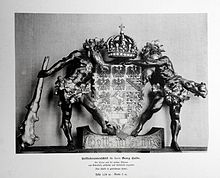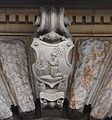Hulbe house




The Hulbe-Haus is an office and commercial building in Hamburg , Mönckebergstrasse 21, which is a listed building. It was built in 1910/11 to designs by the Hamburg architect Henry Grell (1870–1937) and is named after its owner, the bookbinder and leather artisan Georg Hulbe .
history
The Hulbe-Haus, originally called the "new Hulbe-Haus", had a previous building in the St. Georg district in Lindenstrasse 43/47 since 1889. The large workshop was housed there and at the same time there were exhibition rooms for “interesting collective exhibitions by outstanding artists”. The exhibition space of the “Hulbe Arts and Crafts House” in St. Georg had 500 m² of floor space and 1,300 m² of wall space. The shop in Hamburger Hof at Jungfernstieg No. 26 also served artists as an exhibition platform.
Hulbe had the building built on Mönckebergstrasse as the location of his arts and crafts shop, which also operated as the Hulbe arts and crafts house , right next to the St. Petri Church . In the development of Mönckebergstrasse he wanted to set an urban accent between the office buildings with this building . The building takes up the architectural forms of the Dutch Renaissance and thus also the tradition of the Nordic seaside towns.
From the Georg Hulbes community of heirs ("G. Hulbe Testament") the house was transferred to A. Voss Verwaltungsgesellschaft in Bramfelder Strasse 140–152 (margarine factory) in the 1930s and to the "Alfred Voss heirs" in the 1960s who are known in Hamburg as patrons in the sense of Alfred Voss. The shop space on the ground floor was rented to Hugo Sonnenberg's "House of Technology". The house was later sold to the auditor Otto Gellert , the general agent of the Alfred Voss heirs.
A cog made of gilded copper sheet is mounted on the roof of the house , a symbol of the Hanse and Hulbes company logo. This cog contained documents from the construction period and, along with other parts of the house, had to be restored after a severe storm in 1978. After the work, the documents were handed over to the Museum of Art and Industry . The house is currently used by Thomas i Punkt , a shop for fashion and skateboarding equipment.
The sculptures for the reliefs on the outer facade were created by Hermann Perl . The representation on a relief panel (front right) on the Hulbehaus explained the Hamburger Abendblatt in 1983 in an article about Mönckebergstrasse:
“Two attractive accents in the street
(…) The Hulbe House (number 21) also has a special relationship with the mayor of Mönckeberg. It was built in 1911 in the style of an old Flemish town house. A stone tablet hangs on the facade, although only the initiated can interpret it. It testifies to a dispute between the renowned Hamburg bookbinder Hulbe and Mayor Mönckeberg . He was offended by a somewhat revealing drawing by a young lady that Hulbe had exhibited in the window of his workshop on Jungfernstieg. Hulbe had to pay a fine of 50 marks. Which he didn't just accept. He had the stone tablet on his house announce what he thought of the matter and of Mönckeberg. The sculpture shows a monk (who is also at the center of the Mönckeberg family coat of arms), who rides a donkey led by a fool and pulls the flag of art through the dirt behind him. "
However, this description is not entirely accurate: Mayor Johann Georg Mönckeberg died in 1908. The dispute concerned his younger brother, the lawyer Rudolf Mönckeberg . The former state councilor of the tax authority Leo Lippmann (1881-1943) describes the process in his memoirs:
"Dr. Rudolf Mönckeberg was one of the fiercest opponents of the Social Democrats. A relief that is attached to the Hulbehaus in Mönckbergstrasse reminds of him. Dr. Mönckeberg was offended by the fact that drawings by the painter Reznicek for the Munich-based “ Simplicissimus ” were on display in the shop window of the Hulbe shop (at that time: on Alten Jungfernstieg) , depicting little-clad women. On the basis of the court testimony of Mönckeberg, Hulbe was sentenced to a small fine (50 marks) for “ causing a public nuisance ”. Hulbe took revenge by having a relief put up on his new office building in Mönckebergstrasse: a monk riding a donkey up a mountain and calling out his familiar expletive phrase after the Hummel ""
In 1997, Anja Katthöfer reported in her master's thesis that Hulbe had very much disturbed Rudolf Mönckeberg's manner, because they knew each other and he would have removed the relevant images immediately if Rudolf Mönckeberg had pointed them out to him. The trial of the spring of 1911 also found widespread coverage in the contemporary press. Hulbe has left a "letter to posterity" in the golden cog on the ridge of the Hulbe house. In it he criticizes the superficial artistic endeavors of his time and concludes the letter with the words: “Unfortunately, I find this confirms my concern that good old solid technology is declining more and more in all areas of the craft by the many theorists. What might that look like after 100 years ...? "
- Details from the Hulbe house
See also
Individual evidence
- ↑ Harald Richert: Old families in Bergedorf - Georg Hulbe . In: Lichtwark . 46, p. 6. Ed. Lichtwark Committee, Bergedorf, 1982. See now: Verlag HB-Werbung, ISSN 1862-3549 .
- ↑ Hamburg address books , various years
- ↑ Emil Nolde: Hüllenofts Hof. The story of an image. 2002, pp. 38/39
- ↑ Heinrich Steinfath in: “Two Hummelsbüttlers designed the St. Pauli Elbe tunnel: Hermann Perl and Hermann Wessely”. in; Yearbook of the Alster Association 1991, page 44
- ^ Leo Lippmann: My life and my official activity. Memories and a contribution to the financial history of Hamburg. (= Publications of the Association for Hamburg History , Volume 9.) Christians Verlag, Hamburg 1964, p. 145.
- ↑ quoted from R. Joppien in: Yearbook of the Museum for Art and Industry Hamburg , Volume 14 (1995), page 61.
Sources and literature
- Blue plaque on the Hulbe House
- Hulbe house. In: Hamburger Abendblatt from July 24, 2002
- Directory of Hamburg monuments
- Anja Katthöfer: Georg Hulbe (1851–1917). A Hamburg artisan in the age of historicism. unpublished master's thesis, University of Kiel, 1997.
- Rüdiger Joppien : Georg Hulbe's letter of honorary citizenship for Gustav Christian Schwabe. In: Yearbook of the Museum for Art and Industry Hamburg. Volume 14 (1995), pp. 43-66.
Web links
Coordinates: 53 ° 33 ′ 2.5 ″ N , 9 ° 59 ′ 50.9 ″ E








